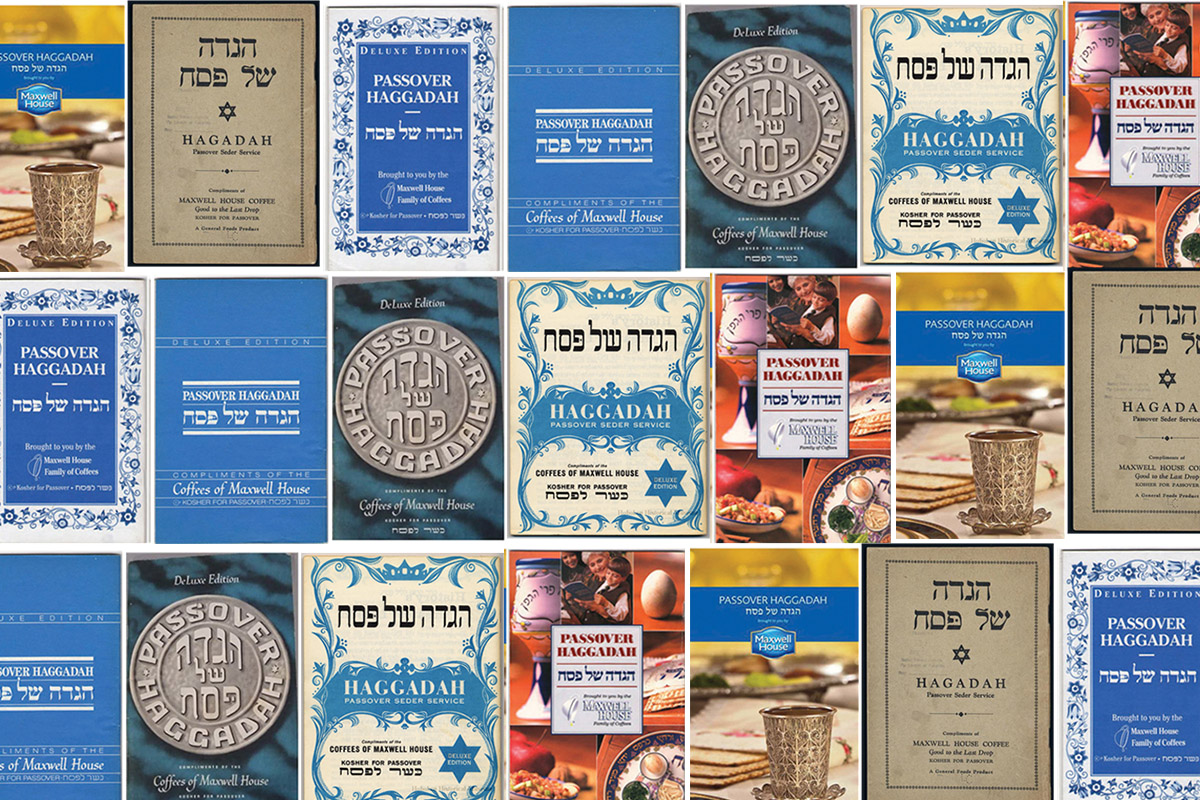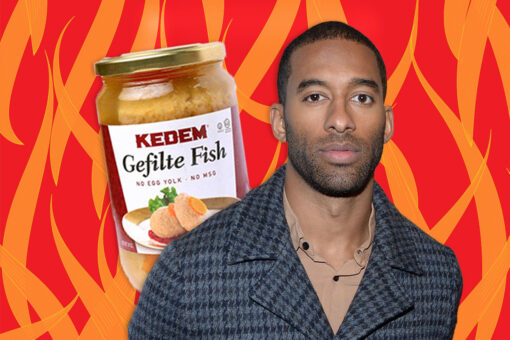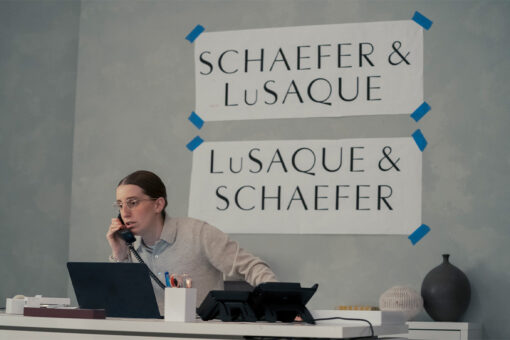“Keep the Tradition… Cherish the Moment… Share the Holiday…” said no Jew ever. And yet, this saccharine statement has a prominent position on the seder table of more than 50 million American Jews, in the endpaper of the Maxwell House Haggadah.
I come from a big, boisterous family in the Cleveland suburbs, and we throw a hell of a seder. For decades my late uncle Willy, a prominent local doctor, reclined at the head of the table as he led the service for our growing family. One year, I gifted him a beautiful hardcover haggadah, a souvenir from Israel. He gave it pride of place on the credenza, but for the seder, we still defaulted to the Maxwell House Haggadah (MHH). We had dozens of copies that, though stained and ragged, allowed everyone to participate. And when you’re a big, boisterous family, everyone always participates.
After the nirtzah, the prayer that next year we might celebrate in Jerusalem, came the main event: my aunt Sandy’s brisket. Her recipe is simple:
- Buy the first cut (“Put that in!” she instructed when I interviewed her for this piece).
- Combine Goodman’s Onion Soup & Dip Mix, Rokeach Condensed Mushroom Soup, and red wine.
- Slather the meat and roast it for three hours.
Who needs Jerusalem when you’ve got the suburbs?
You may have had similar convenience foods lurking around your seder table. Unless somebody debones and grinds carp before poaching it in fish stock, the hardest part of gefilte fish is opening the jar. Aunt Sandy, balaboosta extraordinaire, makes matzah ball soup from scratch, but let’s face it, that Manischewitz box delivers.
Restrictions notwithstanding, the Passover seder is a beloved holiday meal. It’s our Thanksgiving, when we eat a combination of certain dishes that, sure, we could have any time of the year, but there’s magic in seeing them all together on the fancy plates. In Salt, Fat, Acid, Heat, Samin Nosrat writes, “The reason why everyone spoons so much cranberry sauce over everything at Thanksgiving is that on most tables, it’s just about the only form of acid available.” If you go crazy with the horseradish at seder, you’re making the same adjustment.
While the foods on the seder plate are elemental, the seder meal was, like Thanksgiving, more or less determined by economic and culinary changes in mid-century America. The rise of national supermarket chains and mass-produced food products in the 1930s and ‘40s made it possible for people to find frozen green beans, French’s onions, and canned mushroom soup, irrespective of season or location. And that’s how American Passover food became so — and I’m sorry but there’s really no other word for it — goyish.
In this sense, Jewishness defines itself against goyishness as an aesthetic value, a measure of taste. A synonym for goyish isn’t Christian, it’s tacky. And nothing embodies the goyishness of Passover more than the Maxwell House Haggadah.
The world’s most ubiquitous haggadah, the MHH was the brainchild of Jewish advertising executive Joseph Jacobs. Working for Maxwell House in 1923, Jacobs confronted the Ashkenazic debate about whether the coffee bean should be prohibited during Passover along with other legumes. He engaged a rabbi who opined that the coffee “bean” was actually a berry. (In fact, it’s the pit of the cherry-like fruit of the coffea tree.) A full-page Maxwell House ad in the Yiddish newspaper The Forward publicized this judgment and declared that coffee could be the “fifth cup” at your family’s seder. The first MHH came out about a decade later.
The MHH was an immediate success because of its dual-language layout, streamlined text, and free distribution. Technically, it’s free with the purchase of any Maxwell House product, but as rabbi and historian Carole Balin says, “I don’t think 50 million cans of coffee were sold, let’s just put it that way.” Whereas certification organizations, then in their nascency, advertised kosher products through newsletters posted in synagogues, Jacobs’ campaign tapped into the uniqueness of Passover itself: observance in the home, and, consequently I think, the holiday’s popularity. So Jews who didn’t regularly go to temple but still hosted or attended seders (which, then as now, was many of us) could learn that coffee was kosher for Passover, and get a haggadah for their whole family to boot.
In consultation with rabbis, scholars, and ad execs, the MHH has been revised a number of times. The 1960s “DeLuxe Edition” introduced transliterations, as well as the now iconic azure cover. Hand-drawn illustrations depicted the 10 plagues (kinda cute), hands splitting matzah, and a very goyish tableau: a freckled singing boy, his leering uncle and benignly drunk parents. In 2011, the English translation was updated for gender neutrality, and the drawings were replaced by photographs, tinted unnaturally azure, of a Hallmark-looking family celebrating Passover. In an unintentionally meta detail, they’re using the DeLuxe Edition. The 2019 edition was cynical even for branded content: a Marvelous Mrs. Maisel cross-promotion available exclusively through Amazon.
But the MHH represents just one chapter in the commercial history of this holiday. Manischewitz and Streit’s used to produce their own haggadahs, and Rokeach published Passover cookbooks; editions from the 1930s had recipes in English and Yiddish. The recipe for Coca-Cola was tweaked in order to be certified kosher in time for Passover 1935, although by then it was already a fixture on seder tables, even replacing the wine during Prohibition. Still, a rabbi writing a culinary advice column in 1938 opined, “As we ourselves do not drink Coco-Cola during the year, we certainly would not drink it on Passover.” Growing up in the ‘90s, I was similarly puzzled by the annual availability of K for P marshmallows.
Today, as a new generation takes over the duties of hosting Passover, foodie culture has banished the convenience products that revolutionized cooking for our mothers and grandmothers. The same trend transformed Thanksgiving in recent years, with home cooks brining turkeys and swapping out the green beans’ canned mushroom soup for fresh cremini. Changes in foodways and family structures brought Friendsgiving into the mainstream. Maybe Friendsover will be next.
And yet, there is something providential about the Maxwell House Haggadah. The number of Jews in the U.S. has grown by more than 10 million since Joseph Jacobs first forged this partnership, and the seder remains our most observed ritual. As high-quality, small-scale coffee producers gain popularity, it seems clear that the haggadah has helped Maxwell House stay afloat. The coffee company is now a subdivision of Kraft Foods, but the haggadah is still published by Joseph Jacobs Advertising.
And the image of big, boisterous Jewish families, sitting around a table in anticipation of their favorite holiday meal, all reading from the same book? Well, it’s all Joseph ever dreamed.



